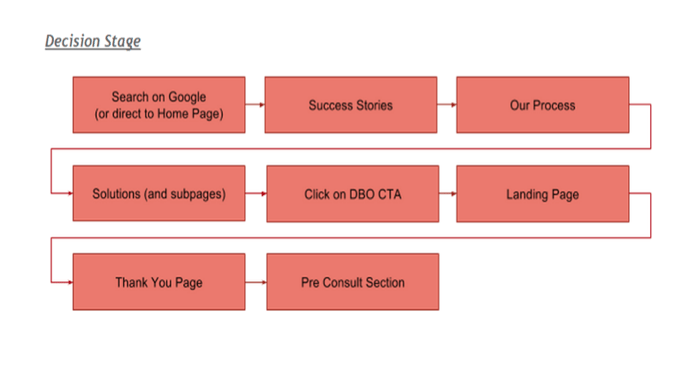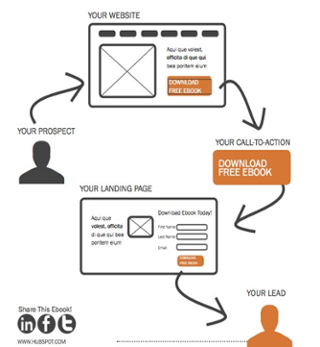
A business website. It’s the face of the company. They can be a form of introduction yet allow a company to give insight to their inner workings. If done correctly, they can also be a source for attracting future clients. With that being said, do you think your current website is equipped to attract your target audience and convert them into a qualified MSP lead? If the answer is a big N-O (maybe you even giggled a little), then it’s time to consider a website redesign.
It’s possible you have been thinking about redesigning your MSP website for some time but your just a bit apprehensive about how much it’s going to cost and if it will actually work the way it should. Of course, you want to have the right team in place to help you build a functional site that does more than just look pretty. To truly make your website a lead conversion machine, there is a certain approach to take, a method, if you will, that can ensure your site will perform it’s best over time. We’ve segmented this process into five definitive stages.
STAGE 1: STRATEGY
Strategy will always be the first step. Without a plan in place, most projects are doomed for failure. In order for a website to perform as it should, the proper foundation must be laid out. This will include a number of actions that will be the basis for aligning your redesign with the intended outcome.
- Define your goals: Outline exactly what you want to achieve from your website and make those goals quantifiable. Whether it be increasing the number of visitors on your site by 50% in six months or generating five new targeted leads in a certain amount of time, make sure the goals can be measurable and are realistic.
- Benchmark current data: Learn exactly how your current website is performing so that you have something to compare your new one to. Gather you monthly averages and input the data into a spreadsheet for future use. Include what tool you used, such as Google Analytics, so that you can use the same one when comparing your new site.

-
Form your brand: Defining your brand is an important step in not only creating written and visual content for your new website, but it will also determine the style and tone of content across other platforms such as your blog and social media. You should begin with establishing your Unique Value Proposition (UVP), also referred to as a Unique Selling Proposition. This should clearly state the benefits of your services, products or idea, how your offering will fulfill a client or customer’s need, and what differentiates you from your competitors.
-
Identify your buyer personas: Detailing your buyer personas is a critical step before starting a website, launching a marketing campaign, implementing a sales process, even before creating a product or service. A buyer persona is a fictional representation of your ideal customers. These personas should include more than just general demographical data, you need to really dive deep and elaborate on each persona’s story. Most businesses will have more than one persona so it’s essential to outline each in great detail.
You want to identify what their struggles are. Are you providing a product or services that will directly solve or alleviate one of those problems or issues? Determine what will they be looking for when seeking out your company. This will be different at each of the buying stages so be sure to clarify. You should also be aware of who or what influences their purchasing decision. Begin with gathering data about your different personas. Search for trends in your current database, obtain feedback from your sales team, interview your current customer base, and collect information form prospects through specific questions on your lead capture forms.
Your buyer personas will be the premise for your content creation, allowing you to personalize your marketing in order to capture the attention of the audience you’re after.

STAGE 2: PLAN
Now that your strategy is defined, it’s time do devise a plan of attack. There are quite a few details to hash out before actually beginning the design aspect of your site.
- Things to consider: Before you think of completely scrapping your old site and starting from scratch, determine what elements were working or not. Outline what you currently like and dislike about your current site. What elements do you feel are missing? How does your current site compare to your goals and what needs to be different? For your new site, what is the first impression you would like to give your target audience? How will you convey a feeling of authority and trust?
- Inventory of current website: It’s important to understand how your existing site is functioning for you and what errors need to be addressed in your redesign. Take an inventory of your current site to discover what your most shared or viewed content is, which of your pages have the most traffic, which are your highest ranked pages, which pages have links and where are those links coming from, what are the most powerful links, which keywords you are ranking for, and what is generating most of your leads.Those pages that are performing well for you are assets and will need to be protected by using 301 redirects. You do not want a drop in traffic or leads. You can use tools such as HubSpot’s Website Grader to evaluate your current site.

STAGE 3: CONTENT
The content that is created for your site, blog and social media is one of the most important factors in this whole processes, sometimes more so than the design itself. If you are not sending out the right message and answering the right questions for your audience, the whole redesign can be considered a waste of valuable time and money.
It’s important to understand that there is a hierarchy of needs with website users. They first look for accessibility. Will they be able to navigate through the site on the specific device they are using? Then they look for relevance. Is your site giving them the information they wanted to know? Next is usability or user experience. Can they easily find what they need on your site? After that they look for personal connection. Does your website cater to the user’s specific need? Lastly they look for persuasive content. Is your site providing the information they are looking for in a credible or compelling manner? The content you offer should draw the user in and want them to ask you for more.
- Site architecture and information structure: Constructing the appropriate flow for your users to follow is crucial for the lead conversion process. Your goal here should be to direct a visitor to an action that you want them to perform (i.e. fill out your lead capture form). So how do you get a visitor to fill out a form? Provide them with the information they seek. Refer to your buyer personas and write out specific questions that you believe they will have at each stage of the buyer’s journey. Write down the answer to those questions then map out how you want that persona to navigate through your site. At each point throughout this funnel you should be providing tidbits of information that proves valuable to that persona. That way they will continue navigating through your site, eventually ending on a landing page.

- Contextual conversion strategy: Now that you have all of the pertinent questions answered for your visitor, you now want them to fill out your lead capture form. The best way to get this visitor to fill out their information on your MSP website is to provide them with an offer that they find valuable. Remember that this will be different at each buyer’s stage. A contextual conversion refers to this exactly. When someone is in the awareness stage, you should be offering something along the lines of a “how-to” e-book. In the consideration stage the offer can be an expert guide that solves a specific problem. Then at the decision stage, a more appropriate offer would be to have them sign up for a free consultation. When planning out your information structure, be sure to pair each of those pages with an offer that will be relevant to that content.

- It’s all about the user: Creating the right content is challenging for many. It’s easy to fall into the trap of writing about your company and wanting to tell the world how great you are and what you are the best at. Instead, pick one aspect about your company that makes you different from your competition and highlight that. When it comes down to it, the user just wants you to provide them with the information they are seeking. If the content that you are providing aligns with their needs and answers specific questions that they have, then you are on the right track. Focus on them. This includes when you are creating a keyword strategy and on-page strategy.
STAGE 4: DESGIN, BUILD AND OPTIMIZE
Now comes the part where the designers and programmers come into play. You are ready to build your site with the proper foundation in place. This section can essentially be an entire blog post on it’s own, but since the focus is on creating a website for greater lead conversions, I’ll just cover a few points.
- Simple design elements to consider:
- A more modern approach to web design includes simplifying certain elements so that the user is not overwhelmed and can focus on the aspects you want them to. This includes typography. Choose a unique font face that is relatable to your industry and is easy to read. Try making fonts larger so you can make messages more clear and concise.
- Use large and bold images. Relating an image to one of your messages is a great way to capture people’s attention. The use of images that take up the full width of your screen is a great way to do that. This is especially useful when creating a call-to-action. Use an image with your call-to-action text instead of a button, for a stronger visual effect.
- Stay away from overly technical elements. There are some very cool looking effects out there, but using too many can prove to be distracting for your users. Stick with simple, clean designs with maybe one element that you really want to stand out such as an offer button.
- Feature videos can be very helpful. If you have a product or service, having a short video on your site that highlights a few key points is a great way to influence users in the decision making process by allowing them to see the value in a product.
STAGE 5: ANALYZE YOUR WEBSITE
After all of the design aspects are complete, you are now ready to launch your site. This, however, doesn’t mean that your site will start converting leads right away. A website is something that should be continually worked on until the goals are achieved.
- Prioritize weekly: The evolution of your website will take some time so do not be discouraged. Although the actual design aspects may only take a few weeks to complete, actually converting customers into leads is an ongoing process. In the beginning, it’s best to identify the easiest conversion opportunities and implement those first while you are working on a more defined content strategy. By developing an inbound marketing plan of action, you can determine what is a priority and execute on those priorities on a weekly basis. In this way you are continuously working toward your goal of increasing your MSP leads.
- Measure and test your impact: Having the tools in place to ensure you are measuring each of those priorities you are executing is paramount. You want to understand exactly what is and isn’t working so that you can adjust accordingly. With tools such as Analytics, user testing, heat maps, polling tools and more, you can identify how your site is performing, the specific conversion rates for your landing pages and calls-to-action, what the bounce rates are for each of your pages, and even what type of engagement you are receiving. You should also perform A/B testing on your landing pages to see which ones are performing better.

You can see how an MSP website redesign is more than just updating the look and feel of your site. You should be building a site that will perform for you in the long run, meaning creating a site that is acts as a magnet for your target audience. This can be accomplished by strategizing, defining your goals, identifying your buyer personas, mapping out the flow of your content for those personas, aligning that content with contextual offers, then continually analyzing and tweaking your website content and adding new content until you see your desired results.
If your company is considering a website redesign, The Rizen Team can work with you to devise a strategy and plan of attack, help you define your goals and your target buyer personas, and map out a content strategy that will allow your website to be the lead conversion machine you’ve always wanted.








No Comments Yet
Let us know what you think